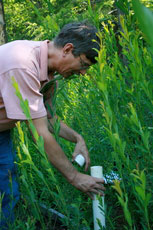Oct 20 2008
At the sprawling Fort Drum military installation in New York, 23,000 willow plants are cleaning up the site of a 164,000-gallon plume of fuel that has been spreading underground for more than 50 years.
 Dr. Christopher Nowak checks the water level at Fort Drum using a piezometer
Dr. Christopher Nowak checks the water level at Fort Drum using a piezometer
Energy for the cleanup is provided by the sun, negating the need to construct a treatment plant that would have cost up to $8 million.
Dr. Christopher Nowak, a silviculturist at the SUNY College of Environmental Science and Forestry (ESF) in Syracuse, N.Y., believes it is the largest phytoremediation effort — the process of using plants to remediate contaminated soils and groundwater — in North America.
The trees are part of an aggressive cleanup strategy to remediate groundwater contamination caused by fuel that leaked from the tank farm along Fort Drum’s “Gasoline Alley.” The military installation, home to the Army’s 10th Mountain Division — Light Infantry, covers more than 107,000 acres. This year, the base is marking its 100th year as a military training site.
No one knows exactly when the leaks began — perhaps as early as World War II — but they were discovered in 1988, when the petroleum, which had been spreading underground for many years, began to foul small creeks on the base.
The plume has been flowing downhill under the Old Sanitary Landfill, which closed in the mid-1970s. It moved through the sandy soil and showed up in groundwater that surfaced as creeks in low-lying areas. The creeks were turning rusty brown with precipitated iron and bacteria as the petroleum surfaced in “seeps” that brought groundwater to the surface.
Donald J. Beevers, the installation restoration project manager, who is employed with contractor Applied Services & Information Systems at Fort Drum, said roughly $1 million has been spent on the remediation project. He estimated that constructing a treatment plant would have cost $8 million.
The goal is to develop a phytoremediation model that can be tailored for use at similar sites across the United States.
“We want to transfer the technology,” Beevers said. “This isn’t the only Department of Defense landfill.”
Said Nowak: “This is just one military base of many, and it was clear that what we are doing here could be applied elsewhere. It’s tailored phytoremediation.”
Nowak and his colleagues began with a small pilot plot, which expanded over the years to 2 acres. He has experimented with some 30 varieties of willow trees and shrubs to see which ones grow best.
As a silviculturist, Nowak’s specialty is the care and tending of tree communities. Part of the challenge in this case was finding a way for the willows to grow in the contaminated soil. He settled on planting boxes, bottomless wooden frames filled with soil that contained enough nutrients for the young plants to establish themselves before the roots reached soil that was soggy with petroleum-laced water.
It was a laborious task. His students lugged in enough soil to fill the original 60 planting boxes. The expanded system has nearly 900 planting boxes that were filled by contractors using a specially designed machine to pump soil across the site.
Now the landscape is dotted with monitoring wells and piezometers that track the level of the water table.
ESF is one of many partners in the project, which also involves installing a new cap on the old landfill.
Nowak said the willows are a cost-effective, environmentally friendly way to treat the contamination.
“Photosynthesis drives the system. It’s a sun-driven system with transpiration of water as the key,” he said. “Ecological engineering projects like this relinquish control to nature. We’re getting sedges and cattail in here. They came for free and are contributing to the phytoremediation.”
There are also asters, goldenrod and several grasses thriving among the willows. Protected by fencing from foraging deer, the willows are leafy and densely planted. The biggest ones absorb five gallons of water per day. At the quarter-acre site of the pilot project, 5,000 to 10,000 gallons of water per day are pumped from the site by the willows. Without the willows, that water would flow into the creek.
The willows do their work naturally. Uptake of water lowers the water table and allows roots to grow. Root systems create a habitat that invites the presence of bacteria and fungi that break down contaminants; the plant uses some of these molecules for its own growth; and willows recycle a lot of water back into the atmosphere through transpiration, releasing some contaminants in greatly reduced concentrations.
The goal is to reduce the volatile organic compounds, particularly the concentrations of benzene, toluene, ethylbenzene and xylenes, the compounds of concern in petroleum-based fuel.
“The reason the contaminant stream is there is the training,” Nowak said. “It’s the cost of doing business for the Army. “
He said monitoring efforts indicate that the contaminant concentrations are lower than they were before the willows were planted.
ESF’s many partners in the project include the Army Corps of Engineers; the Army Environmental Command; consultants Malcolm Pirnie Inc., Engineering and Environment Inc. and EA Engineering, Science and Technology Inc; and the New York state Department of Environmental Conservation.